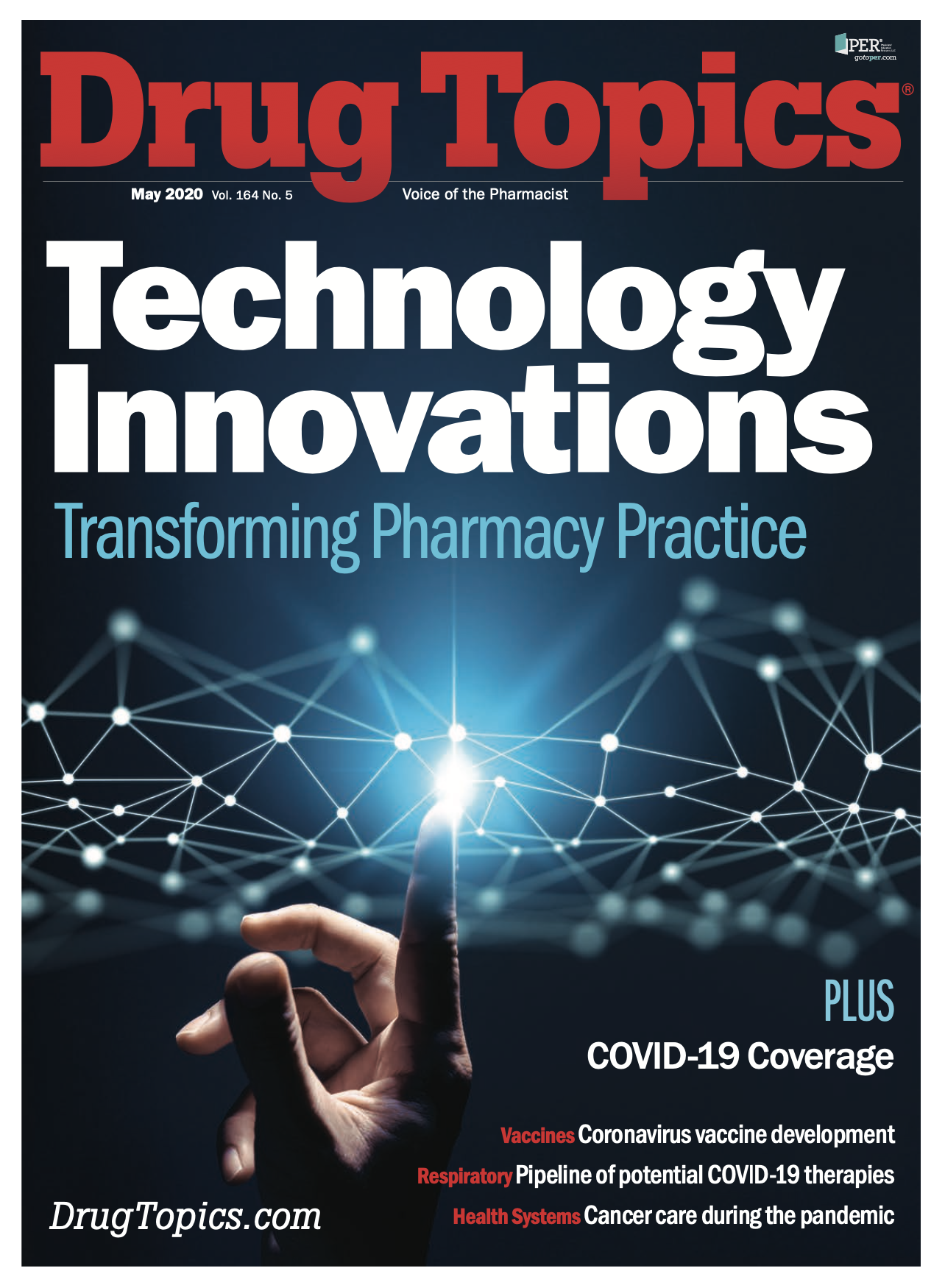Technology Innovations Transforming Pharmacy Practice
New digital health products are providing more insight into data and the opportunity for real-time patient interaction.

Shane Bishop, BScPharm

Yuri Maricich, MD, MBA

Robert L. Alesiani, PharmD

Clint Pridgen, Platform Leader, MedMined Surveillance Services at Becton, Dickinson and Company

Digital health technology is transforming every aspect of pharmacy practice, whether it deploys robotics to fill prescriptions, uses analytics to track medication data, or offers access to digital therapy. Pharmacists in both the hospital and retail settings are using recently developed technology to prevent adverse drug effects, monitor the use of antibiotics, modify unhealthy behavior, and promote medication adherence.
Not only can technology make a pharmacist’s day more efficient by automating repetitive tasks, but new digital health products are providing more insight into data and the opportunity for real-time patient interaction.
Monitoring Medication
One type of digital health technology that helps pharmacists monitor adherence is an at-home medication dispenser that lets them know, in real time, whether the patient is actually taking the medication.
Developed by Catalyst Healthcare and a feature of the Pack4U connected care system, spencer is a dispenser and monitor that not only reminds patients when it’s time to take medication but offers them a way to communicate concerns remotely with a pharmacist, who can then troubleshoot any required solutions. The integrated system offers several advantages in treating high-risk patients, who are often on multiple medications.
“The pharmacy in our model is usually responsible for delivering a specially packaged cartridge to the patient, and then at the patient level, we have the device that sits on the patient’s countertop, called spencer,” said Shane Bishop, founder and CEO of Catalyst Healthcare and Pack4U. “The patient can slip the cartridge into the device. We check and make sure the right patient gets the right cartridge for the right device, and then the pharmacy is connected in real time with the device on the countertop.”
When the patient takes out the medication, a question may pop up on the screen, such as “How are you?” Or the question can be customized to the particular medication or condition.
Prescriptions are packed centrally, then shipped back to pharmacies. Each step of the process is tracked, including who sent the order, where the order is, who received it, and even expiry dates. Spencer also notes adherence problems, while collecting data on medication use, that can prove valuable to research.
“You get the responses back in real time,”said Bishop.“So now you can turn that data into being proactive for that patient and even triage that information for clinicians and physicians, as well as making pharmacy very relevant in the care of the patient, because pharmacists can get access to data faster than anyone else involved in care.”
Telehealth solutions have been invaluable during the quarantine prompted by the coronavirus disease 2019 (COVID-19) epidemic, providing a link to housebound patients who require ongoing care for chronic conditions.
“Our adherence rates run at 98%, and that’s actual medication in the patient’s hand at the time they are supposed to take it,” said Bishop. “It keeps the patient safe at home and lowers the total cost of care.”
Although the system primarily works with retail pharmacies, hospitals can discharge patients with the device so a pharmacist network can remotely monitor the patient. One advantage to this technology, according to Bishop, is that pharmacists have more time to focus on patients.
“I believe there is a lot of capacity in pharmacy to do much more than they’ve been tasked with,” he said.
Digiceuticals and Behavior Modification
When it comes to behavior modification therapy, there’s now an app for that-an app that requires a prescription.
Technology-based therapy, known as digiceuticals, uses FDA-approved apps on smartphones, tablets, and other mobile devices to gather data and provide patients with real-time guidance.
Digiceuticals can be used as monotherapy or in addition to medication. Pear Therapeutics created reSET, which can be used as an adjunct to a contingency management system, to treat some forms of substance abuse. The company’s reSET-O targets opioid addiction as part of a treatment plan that also includes medication. Somryst, the company’s newest product, provides cognitive behavioral therapy for chronic insomnia.
“As these products become more and more sophisticated in relation to [their] use in conjunction with other medications, the role of the pharmacist is going to be how to use them in terms of the patient’s overall medication,” said Yuri Maricich, MD, MBA, chief medical officer and head of development at Pear Therapeutics.
A code is required to access these apps. Before dispensing the code, pharmacists need to review the patient’s profile. “With all of these [apps], the way they are dispensed is [by] the prescription [being] sent to a specialty pharmacy where a pharmacist reviews the information,” said Maricich. “A pharmacist reviews every script. If everything looks copacetic, they actually dispense and fill, providing patients with a prescription access code. The patient then goes to Google Play or the Apple apps store. They download the software, input their prescription access code from the pharmacy, and get access to that treatment for the prescription duration. If the patient wants a renewal or a refill, that can be done."
According to Maricich, the difference between digiceuticals and biologic medicine will eventually fade away until it will all simply be described as medicine. “This is something that can be prescribed through a telemedicine visit and filled and used MBA without ever having to physically go to a clinic,” said Maricich. “In an era where we’re moving into virtual care, it will fit more and more into models outside traditional brick-and-mortar care delivery.”
Preventing Adverse Effects
According to the CDC, between 2013 and 2016, almost half of all Americans took at least 1 prescription drug in the prior 30 days, 24% took 3 or more, and 12.6% took 5 or more, raising the risk for adverse effects (AEs). To assess risks in patients taking multiple medications, The Tabula Rasa HealthCare (TRHC) MedWise Risk Score (MRS) employs technology that identifies and aggregates markers of AEs.
“These risk factors are considered in an algorithmic approach, designed using millions of patients’ data, which creates the MedWise Risk Score,” said Robert L. Alesiani, PharmD, chief pharmacotherapy officer at TRHC. “Each patient has a dynamic risk score that changes with modification in medication therapy. We can pinpoint and act upon medication risks identified using the risk score. We also can predicate the impact of MRS, including changes in total medical spend. The MedWise system is built by pharmacists for pharmacists, incorporating the array of science we learned in pharmacy school-pharmacodynamics, pharmacokinetics, pharmacogenomics, pharmacology, and chronopharmacology.”
Rather than depend on a series of 1-to-1 drug interactions for each patient’s drug profile, the system performs a simultaneous aggregate drug interaction check that can help identify high-risk and unsafe medication regimens, overprescribing, inappropriate prescribing, overutilization, improper or suboptimal administration schedules, and drug-gene and drug-drug- gene interactions. By reducing the AE risk, the analysis also lowers the medical costs associated with treating potential health problems.
“Without a complete medication reconciliation, profile omissions represent interactions missed, increased risks of oversedation, symptoms of delirium [and] confusion, impaired gait leading to falls with injury, irregular heart rates, and, at worst, sudden death,” said Alesiani. “When a patient is taking an enzyme-inhibiting medication, it can affect so many other medications on the profile. If we don’t know about that drug, our recommendations could be useless.”
Technology can help pharmacists stay up-to-date on interactions. “When patients are on 2, 3, or more medications that are metabolized through the same drug-metabolizing enzyme, these drugs compete for the metabolism,” said Alesiani. “Pharmacists learned all about this in school, but there’s no way to memorize metabolic pathways for every drug on the market and then efficiently apply that knowledge in daily pharmacy practice.”
Antibiotic Stewardship in Real Time
According to the CDC’s 2019 AR Threats Report, antibiotic-resistant bacteria and fungi cause more than 2.8 million infections and 35,000 deaths in the United States each year. To track and better steward antibiotic use, Becton, Dickinson and Company (BD) integrated new analytics into the company’s connected medication management platform. These analytics provide near real-time alerts when an inappropriate and potentially ineffective antibiotic has been prescribed.
“You have all these players–physicians, pharmacists, and nurses–trying to make sure that the right medication gets to the right patient at the right time at the right dose,” said Clint Pridgen, platform leader, MedMined Surveillance Services at BD. “It seems like that would be a pretty simple process, but every player has a different piece of information and because everyone is moving so fast, that information doesn’t always translate from person to person to person.”
Members of a health care team can receive alerts on lab results and changes in a patient’s condition, which may prompt a timely reassessment of the medication regimen. The results from the latest lab tests might, for example, suggest that a drug that was appropriate from an antimicrobial stewardship perspective when it was prescribed may no longer be the best medication.
Health systems have more data than ever before. Although useful, data can take time to process. A pharmacist who is responsible for 30 to 40 patients each day may receive a constant influx of information, which needs to be organized and prioritized. The COVID-19 pandemic clearly illustrates the need for the efficient collection and organization of data.
“Blending in technology that closes in the gaps in visibility enables you to identify patients that are infected or identify resistant organisms or to identify trends that allow health systems to get in front of pandemics and epidemics as quickly as possible,” said Pridgen.
Digital health care technology makes it easier to derive insight from an over-abundance of information.
“Technology is going to continue to be a driver,” said Pridgen. “But the key is that it’s got to provide actual intelligence. One of the real challenges is visibility because there is so much information, but it’s so hard to pull all those pieces together in an effective mechanism. What you’re going to find with technology solutions is a desire for a mechanism to close the gaps and connect the dots.”
Pharmacy practice will continue to evolve along with the latest technology, which may help pharmacists spend more time interacting with patients.
“I think that pharmacists have al- ways wanted to participate more clinically and drive patient outcomes,” said Pridgen. “I think the technology that’s available now allows for pharmacies to do that.”
